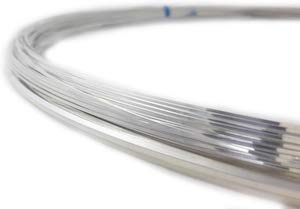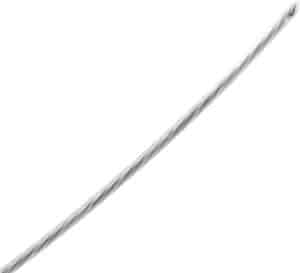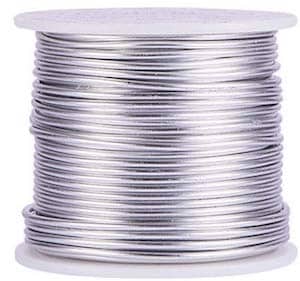A tiara is a jewel-encrusted crown, fit for royalty. Queens, princesses, and anyone else with a penchant for everything elegant need one.
Instead of splashing out a hefty amount of cash on a tiara, you can make your own special one using jewelry wire.
But what wire is best for the job? This is the question we’re going to tackle in this article. Tiara’s are traditionally ostentatious displays of wealth, so as you can imagine, silver and gold wire are the favored options for many.
However, you can make yours from a variety of wires, so long as you consider the gauge and hardness of the wire, to ensure it’ll look like it’s fit for royalty.
That’s why we’re not only going to take a look at what are the best metal wires to use for tiara making, but also the gauge of wire and hardness that you will want to consider for the job.
Finally, the last factor you need to consider when thinking about the best wire for tiara making is the shape. To save you some time, the best option is square wire, but it totally depends on your design.
Best Metal Wire Material for Making Tiaras
Let’s start with arguably the most interesting and exciting part of the process: choosing the right metal wire for your tiara.
Hands down the most fun part of making your own jewelry is deciding what you want the end product to look like, and then picking out the right metal from everything available.
For bracelets, necklaces and other everyday jewelry, you can essentially choose whatever metal wire you prefer. However, with tiaras, there is a certain expectation that they are going to radiate a certain opulence and sense of wonder.
For that reason, the first metals we are going to look at are those that you would most associate with wealth and royalty: silver and gold.
- Gold – One of the rarest and precious jewelry metals.
- Sterling Silver – High-quality and sturdy.
- Stainless Steel – An attractive and affordable alloy metal.
- Aluminum – Beginner-friendly and lightweight.
Gold
There’s a reason the phrase ‘gold standard’ refers to something of the highest quality.
If you want to get your hands on some high-quality gold wire to make your extra special tiara, then I recommend this 22 karat gold round wire from Bedrock Jewelry.
Gold has always been associated with high-end jewelry, so that should make it a very attractive choice if you want to make your own tiara.
So aside from its reputation for quality, what else makes gold one of the best options for tiara making?
The rarity of gold as a metal is partly what makes it so sought after, and so revered as a jewelry material. Wearing a tiara should make you feel special, and there isn’t a better way of doing so than using a material that isn’t readily available in the same way as others.
Something you may not know about gold is that it is ultra-resistant to the effect of tarnishing. As a result, it will keep its characteristic shine and bright color for a very long time.
Gold wire as a material is considered to be relatively straightforward to use. Furthermore, it offers you the opportunity to make incredibly detailed jewelry, due to its constitution and malleability.
Finally, the rich color of gold can’t be replicated. While other metals like brass or copper may come close to imitating the same regal shade of yellow, it’s easy to recognize real gold when you see it.
An excellent product that is perfect for any tiara, what I like about this wire is that it’s visibly high-quality gold, and will make it a beautiful tiara. Although it’s round wire, and not square, you can still make an amazing tiara with it.
Bear in mind that the lower the gauge the better for making a tiara, so out of those available, I would suggest that you go for the 18 gauge option.
Sterling Silver
Second best in the context of competition, sterling silver is anything but in the world of jewelry.
As for my recommendation, I would give this 14-gauge sterling silver-filled square wire from Craft Wire.
Just like gold, silver has always been extremely high-regarded when it comes to making jewelry. Hence why you always see gold and silver jewelry at high-end jeweler shops.
That being said, what makes sterling silver a great option for a tiara specifically?
For a start, you can work easily with sterling silver, so even if you aren’t an expert jeweler, you can produce a quality tiara. This is due to its flexibility as a metal, yet this doesn’t come at the expense of durability, important for the structure of your tiara.
The plating of sterling silver wire is highly resistant to wear and tear, so you won’t have to worry about your tiara falling apart and deteriorating over time.
The only factor to consider when opting for sterling silver is that there is a chance that it could tarnish, so it’s important you maintain and treat it well, which I’m sure you would anyway be given that it’s a tiara!
Not only does it fall perfectly into the ideal gauge range for tiaras, which we’ll discuss later, this wire has been lauded by customers that have bought it.
Stainless Steel
Now let’s briefly assess some alternative options that are more accommodating to those of us on a budget.
Stainless steel is a sturdy metal alloy, combining the likes of titanium and nickel, resulting in incredibly robust jewelry wire.
Mimicking the color of silver very well, stainless steel is a great, more affordable alternative to the expensive metal wire.
If this sounds like the material for you, try this tiger tail stainless steel wire from Mandala Crafts.
If you decide to make your tiara from stainless steel, you will have a tiara for life. There’s a reason why stainless steel is the preferred metal choice for everything from car parts to kitchen utensils, and that is its ability to withstand the elements and retain its shine.
Then, as we alluded to, stainless steel is a very reasonably-priced wire to get hold of, so that should count for a lot.
The cons of stainless steel are that due to the nickel component, they can cause issues for people with allergies. Plus, the material is very rigid, meaning finer detail might be harder to pull off.
Both soft, and malleable, this wire will be easy to work with. It’s also very sturdy and resistant to abrasion, rusting and fraying.
Aluminum
The second alternative metal that I’d like to propose is aluminum wire. Aluminum wire is similar to stainless steel in a lot of ways, but it also has its own unique properties.
As far as which wire to buy, I would point you towards this product from Benecreat. An aluminum wire available in various gauges, it has been anodized to resemble the shining color of silver.
Aluminum as an option for a tiara is great primarily because through the process of anodization, you can achieve a wide array of bright colors.
As a result, the aluminum metal wire is fantastic for if you want a very unique tiara that stands out. The ability to have such bright colors also makes it a solid choice for making a tiara for a child or someone younger for their birthday for example.
Plus, as you probably already know, aluminum is a very cheap metal wire to buy, making it an attractive choice if you have a tight budget.
Lastly, aluminum is very easy to work with, making it beginner-friendly. You won’t worry about working with it either since it’s not as expensive as something like gold wire.
A cheap option that imitates the amazing appearance of silver, this wire is perfect for sticking on budget while still making a tiara fit for a queen.
Best Wire Gauge for Making Tiaras
Now, onto the finer details of picking your wire for tiara making, let’s go over the best options for wire gauge.
In case you didn’t already know, wire gauge refers to the diameter of the wire. The higher the gauge, the thinner the diameter, and vice versa.
In general, the best wire gauges for making tiaras are the lower ones. Anywhere from 10-18 gauge will be perfect for your tiara-making needs.
We want the wire to be thick since the tiara needs to retain its shape and not fall apart too easily. After all, a tiara is similar to a crown, not something highly delicate, so it needs to be robust and be able to withstand a fall from your head.
Having said this, it may be the case that you have a delicate design in mind for your tiara, which includes bands and cute weaving patterns.
If this is the case, then you are probably going to want to invest in some high-gauge wire on top of the low-gauge wire for the base of the tiara. Something like 28 gauge wire would probably be best suited to the task of creating the finer details.
24-26 gauge wire would be better though if the details you want to add is something like a stamen or branching flower-like display.
At the end of the day, it entirely depends on the tiara design you have in mind when you pick the wire gauge, depending on how intricate you want to make it.
But as I said, the one guideline you should stick to is a low-gauge wire to create the main part of the tiara, so that it will maintain its structural integrity and endure continued use.
Best Hardness of Wire for Making Tiaras
Next up, you’ll need to consider what hardness of wire is best for the job.
Hardness refers to how easy or difficult the wire is to manipulate. So for some jewelry, you’ll want to be able to bend it in elaborate ways, whereas with others durability and rigidness are more important factors.
The hardness of wire can range from:
- soft, easy to bend,
- to half-hard,
- or hard.
Half-hard wire sits in the middle of the two options, a balanced hardness that incorporates the qualities of flexibility with the rigidness required to maintain the shape of the jewelry it’s used for.
Again, it is hard to provide a definitive answer to the best hardness of wire for tiaras, due to different designs requiring different properties.
However, I would suggest that if you want to create some finer details, then use a higher gauge like we discussed, and dead-soft wire.
Dead-soft wire is the easiest to work with because of how malleable it is. That means you can bend it into whatever shape, pattern or design you can imagine.
The downside is, you will have to learn how to harden the wire once you’ve bent it into the desired shape. Otherwise, it will be very fragile.
For the main component of the tiara, I would go with a lower gauge wire like 14 gauge, and half-hard wire.
Half-hard wire is by far the most reliable hardness of wire, as it is flexible but can also hold its shape well.
Best Shape of Wire for Making Tiaras
Finally, let’s go over the various shapes of wire to see which is best for tiara making. The shape of wire refers to the shape you see when you take a cross-section of the wire.
These range from:
- round,
- half-round,
- to square,
- and even twisted.
While round wire is used for the majority of jewelry projects, and it is a very valid option for making a tiara, square wire is arguably the best for tiara making.
The main reason for preferring square wire to round wire for making tiaras is because it is much more suited to the upright shapes present in most tiaras.
Square wire is the best for making designs that require straight lines and a nice, neat structure. That’s why it gets my vote and should be a very strong contender for making your tiara.




